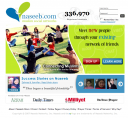



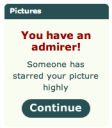



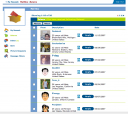
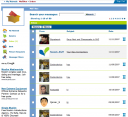
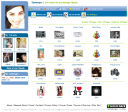
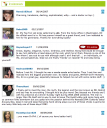
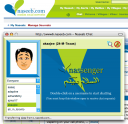
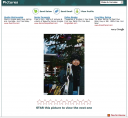

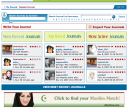

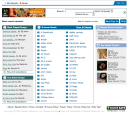



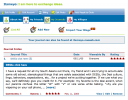
 Naseeb.com (Muslim Social Network)
Naseeb.com (Muslim Social Network)
Article 1
Clustered Social Networks Lead to Company Innovation
Filed in archive Innovation by rob on August 21, 2007
If you want to be more innovative, a new study implies that you may be better off with a small cluster of contacts instead of one massive but loosely linked list. Why? In small networks important information travels quickly, which is a necessary component of innovation.
According to the researchers, companies reap greater benefits when they are part of a network that exhibits a high degree of clustering and only a few degrees of separation, both of which are characteristic of a small-world network.
They found that clustering enables information to travel quickly and accurately because it creates redundant paths between companies and increases the level of cooperation among them. Clusters within networks are important structures for making information exchange meaningful and useful, they add. Clustering can make firms more willing and able to exchange information.
Article 2
The MySpace Generation DECEMBER 12, 2005
They live online. They buy online. They play online. Their power is growing
COVER STORY
The Toadies broke up. It was four years ago, when Amanda Adams was 16. She drove into Dallas from suburban Plano, Tex., on a school night to hear the final two-hour set of the local rock band, which had gone national with a hit 1995 album. “Tears were streaming down my face,” she recalls, a slight Texas lilt to her voice. During the long summer that followed, Adams turned to the Web in search of solace, plugging the lead singer’s name into Google repeatedly until finally his new band popped up. She found it on Buzz-Oven.com, a social networking Web site for Dallas teens.
Adams jumped onto the Buzz-Oven network, posting an online self-portrait (dark hair tied back, tongue out, goofy eyes for the cam) and listing her favorite music so she could connect with other Toadies fans. Soon she was heading off to biweekly meetings at Buzz-Oven’s airy loft in downtown Dallas and helping other “Buzzers” judge their favorite groups in marathon battle-of-the-bands sessions. (Buzz-0ven.com promotes the winners.) At her school, Frisco High — and at malls and concerts — she passed out free Buzz-Oven sampler CDs plastered with a large logo from Coca-Cola Inc., (KO ) which backs the site in the hope of reaching more teens on their home turf. Adams also brought dozens of friends to the concerts Buzz-Oven sponsored every few months. “It was cool, something I could brag about,” says Adams, now 20 and still an active Buzzer.
Now that Adams is a junior at the University of North Texas at Denton, she’s online more than ever. It’s 7 p.m. on a recent Saturday, and she has just sweated her way through an online quiz for her advertising management class. (The quiz was “totally out of control,” write classmates on a school message board minutes later.) She checks a friend’s blog entry on MySpace.com to find out where a party will be that night. Then she starts an Instant Messenger (IM) conversation about the evening’s plans with a few pals.
KIDS, BANDS, COCA-COLA
At the same time, her boyfriend IMs her a retail store link to see a new PC he just bought, and she starts chatting with him. She’s also postering for the next Buzz-Oven concert by tacking the flier on various friends’ MySpace profiles, and she’s updating her own blog on Xanga.com, another social network she uses mostly to post photos. The TV is set to TBS, which plays a steady stream of reruns like Friends and Seinfeld — Adams has a TV in her bedroom as well as in the living room — but she keeps the volume turned down so she can listen to iTunes over her computer speakers. Simultaneously, she’s chatting with dorm mate Carrie Clark, 20, who’s doing pretty much the same thing from a laptop on her bed.
You have just entered the world of what you might call Generation @. Being online, being a Buzzer, is a way of life for Adams and 3,000-odd Dallas-area youth, just as it is for millions of young Americans across the country. And increasingly, social networks are their medium. As the first cohort to grow up fully wired and technologically fluent, today’s teens and twentysomethings are flocking to Web sites like Buzz-Oven as a way to establish their social identities. Here you can get a fast pass to the hip music scene, which carries a hefty amount of social currency offline. It’s where you go when you need a friend to nurse you through a breakup, a mentor to tutor you on your calculus homework, an address for the party everyone is going to. For a giant brand like Coke, these networks also offer a direct pipeline to the thirsty but fickle youth market.
Preeminent among these virtual hangouts is MySpace.com, whose membership has nearly quadrupled since January alone, to 40 million members. Youngsters log on so obsessively that MySpace ranked No. 15 on the entire U.S. Internet in terms of page hits in October, according to Nielsen//NetRatings. Millions also hang out at other up-and-coming networks such as Facebook.com, which connects college students, and Xanga.com, an agglomeration of shared blogs. A second tier of some 300 smaller sites, such as Buzz-Oven, Classface.com, and Photobucket.com, operate under — and often inside or next to — the larger ones.
Although networks are still in their infancy, experts think they’re already creating new forms of social behavior that blur the distinctions between online and real-world interactions. In fact, today’s young generation largely ignores the difference. Most adults see the Web as a supplement to their daily lives. They tap into information, buy books or send flowers, exchange apartments, or link up with others who share passions for dogs, say, or opera. But for the most part, their social lives remain rooted in the traditional phone call and face-to-face interaction.
The MySpace generation, by contrast, lives comfortably in both worlds at once. Increasingly, America’s middle- and upper-class youth use social networks as virtual community centers, a place to go and sit for a while (sometimes hours). While older folks come and go for a task, Adams and her social circle are just as likely to socialize online as off. This is partly a function of how much more comfortable young people are on the Web: Fully 87% of 12- to 17-year-olds use the Internet, vs. two-thirds of adults, according to the Pew Internet & American Life Project.
Teens also use many forms of media simultaneously. Fifteen- to eighteen-year-olds average nearly 6 1/2 hours a day watching TV, playing video games, and surfing the Net, according to a recent Kaiser Family Foundation survey. A quarter of that time, they’re multitasking. The biggest increase: computer use for activities such as social networking, which has soared nearly threefold since 2000, to 1 hour and 22 minutes a day on average.
Aside from annoying side effects like hyperdistractibility, there are some real perils with underage teens and their open-book online lives. In a few recent cases, online predators have led kids into dangerous, real-life situations, and parents’ eyes are being opened to their kids’ new world.
ONE-HIT WONDERS
Meanwhile, the phenomenon of these exploding networks has companies clamoring to be a part of the new social landscape. News Corp. (NWS ) Chief Executive Rupert Murdoch has spent $1.3 billion on Web acquisitions so far to better reach this coveted demographic — $580 million alone for the July purchase of MySpace parent Intermix Media. And Silicon Valley venture capitalists such as Accel Partners and Redpoint Ventures are pouring millions into Facebook and other social networks. What’s not yet clear is whether this is a dot-com era replay, with established companies and investors sinking huge sums into fast-growth startups with no viable business models. Facebook, barely a year old and run by a 21-year-old student on leave from Harvard, has a staff of 50 and venture capital — but no profits.
Still, consumer companies such as Coke, Apple Computer (AAPL ), and Procter & Gamble (PG ) are making a relatively low-cost bet by experimenting with networks to launch products and to embed their brands in the minds of hard-to-reach teens. So far, no solid format has emerged, partly because youth networks are difficult for companies to tap into. They’re also easy to fall out of favor with: While Coke, Sony (SNE ) Pictures Digital, and Apple have succeeded with MySpace, Buzz-Oven, and other sites, P&G’s attempt to create an independent network around a body spray, for one, has faltered so far.
Many youth networks are evanescent, in any case. Like one-hit wonder the Baha Men (Who Let the Dogs Out) and last year’s peasant skirts, they can evaporate as quickly as they appear. But young consumers may follow brands offline — if companies can figure out how to talk to youths in their online vernacular. Major companies should be exploring this new medium, since networks transmit marketing messages “person-to-person, which is more credible,” says David Rich Bell, a marketing professor at the University of Pennsylvania’s Wharton School.
So far, though, marketers have had little luck creating these networks from scratch. Instead, the connections have to bubble up from those who use them. To understand how such networks get started, share a blue-cheese burger at the Meridian Room, a dive bar in downtown Dallas, with Buzz-Oven founder Aden Holt. At 6 feet 9 inches, with one blue eye, one brown one, and a shock of shaggy red hair, Holt is a sort of public figure in the local music scene. He started a record label his senior year at college and soon turned his avocation into a career as a music promoter, putting out 27 CDs in the decade that followed.
In 2000, as Internet access spread, Holt cooked up Buzz-Oven as a new way to market concerts. His business plan was simple. First, he would produce sample CDs of local bands. Dedicated Buzzers like Adams would do the volunteer marketing, giving out the CDs for free, chatting up the concerts online, and slapping up posters and stickers in school bathrooms, local music stores, and on telephone poles. Then Holt would get the bands to put on a live concert, charging them $10 for every fan he turned out. But to make the idea work, Holt needed capital to produce the free CDs. One of his bands had recently done a show sponsored by Coke, and after asking around, he found the marketer’s company’s Dallas sales office. He called for an appointment. And then he called again. And again.
Coke’s people didn’t get back to him for weeks, and then he was offered only a brief appointment. With plenty of time to practice his sales pitch, Holt spit out his idea in one breath: Marketing through social networks was still an experiment, but it was worth a small investment to try reaching teens through virtual word of mouth. Coke rep Julie Bowyer thought the idea had promise. Besides, Holt’s request was tiny compared with the millions Coke regularly sinks into campaigns. So she wrote him a check on the spot.
DEEP CONNECTIONS
By the time Ben Lawson became head of Coke’s Dallas sales office in 2001, Buzz-Oven had mushroomed into a nexus that allowed hundreds of Dallas-area teens to talk to one another and socialize, online and off. A middle-aged father of two teens himself, Lawson spent a good deal of time poring over data about how best to reach youth like Adams. He knew what buzzer Mike Ziemer, 20, so clearly articulates: “Kids don’t buy stuff because they see a magazine ad. They buy stuff because other kids tell them to.”
What Lawson really likes about Buzz-Oven is how deeply it weaves into teens’ lives. Sure, the network reaches only a small niche. But Buzzers have created an authentic community, and Coke has been welcomed as part of the group. At a recent dinner, founder Holt asked a few Buzzers their opinions about the company. “I don’t know if they care about the music or they just want their name on it, but knowing they’re involved helps,” says Michael Henry, 19. “I know they care; they think what we’re doing is cool,” says Michele Barr, 21. Adds Adams: “They let us do our thing. They don’t censor what we do.”
Words to live by for a marketer, figures Lawson, particularly since Coke pays Buzz-Oven less than $70,000 a year. In late October, Holt signed a new contract with Coke to help him launch Buzz-Oven Austin in February. The amount is confidential, but he says it’s enough for 10,000 CDs, three to four months of street promotions, and 50,000 fliers, plus some radio and print ads and a Web site promotion. Meanwhile, Buzz-Oven is building relations with other brands such as the Dallas Observer newspaper and McDonald’s (MCD ) Chipotle restaurants, which kicks in free food for Buzzer volunteers who promote the shows. Profits from ticket sales are small but growing, says Holt.
Not so long ago, behemoth MySpace was this tiny. Tom Anderson, a Santa Monica (Calif.) musician with a film degree, partnered with former Xdrive Inc. marketer Chris DeWolfe to create a Web site where musicians could post their music and fans could chat about it. Anderson knew music and film; De Wolfe knew the Internet business. Anderson cajoled Hollywood friends — musicians, models, actors — to join his online community, and soon the news spread. A year later, everyone from Hollywood teen queen Hilary Duff to Plano (Tex.) teen queen Adams has an account.
It’s becoming a phenomenon unto itself. With 20 million of its members logging on in October, MySpace now draws so much traffic that it accounted for 10% of all advertisements viewed online in the month. This is all the more amazing because MySpace doesn’t allow those ubiquitous pop-up ads that block your view, much less spyware, which monitors what you watch and infuses it with pop-ups. In fact, the advertising can be so subtle that kids don’t distinguish it from content. “It’s what our users want,” says Anderson.
As MySpace has exploded, Anderson has struggled to maintain the intimate atmosphere that lends social networks their authenticity. When new users join, Tom becomes their first friend and invites them to send him a message. When they do, they hear right back, from him or from the one-quarter of MySpace’s 165 staffers who handle customer service. Ask Adams what she thinks of MySpace’s recent acquisition by News Corp., and she replies that she doesn’t blame “Tom” for selling, she would have done the same thing. She’s talking about Anderson, but it’s hard to tell at first because she refers to him so casually, as if he were someone she has known for years.
That’s why Murdoch has vowed not to wrest creative control from Anderson and DeWolfe. Instead News Corp.’s resources will help them nourish new MySpace dreams. Earlier this month they launched a record label. In the next few months, the duo says, they will launch a movie production unit and a satellite radio station. By March they hope to venture into wireless technology, perhaps even starting a wireless company to compete with Virgin Mobile or Sprint Nextel’s Boost. Says DeWolfe: “We want to be a lifestyle brand.”
It’s proof that a network — and its advertising — can take off if it gives kids something they badly want. Last spring, Facebook founder Mark Zuckerberg noticed that the college students who make up most of his 9.5 million members were starting groups with names like Apple Students, where they swapped information about how to use their Macs. So he asked Apple if it wanted to form an official group. Now — for a fee neither company will disclose — Apple sponsors the group, giving away iPod Shuffles in weekly contests, making product announcements, and providing links to its student discount program.
The idea worked so well that Facebook began helping anyone who wanted to start a group. Today there are more than a dozen, including several sponsored by advertisers such as Victoria’s Secret and Electronic Arts. Zuckerberg soon realized that undergrads are more likely to respond to a peer group of Apple users than to the traditional banner ads, which he hopes to eventually phase out. Another of his innovations: ads targeted at students of a specific college. They’re a way for a local restaurant or travel agency to advertise. Called Facebook Announcements, it’s all automated, so anyone can go onto Facebook, pay $14 a day, and fill out an ad.
SPARKLE AND FIZZLE
Still, social networks’ relations with companies remain uneasy. Last year, for example, Buzz-Oven was nearly thrown off track when a band called Flickerstick wanted to post a song called Teenage Dope Fiend on the network. Holt told Buzzers: “Well, you can’t use that song. I’d be encouraging teenagers to try drugs.” They saw his point, and several Buzzers persuaded the band to offer up a different song. But such potential conflicts are one way, Holt concedes, that Buzz-Oven’s corporate sponsorships could come to a halt.
Like Holt, other network founders have dealt with such conflicts by turning to their users for advice. Xanga co-founder John Hiler has resisted intrusive forms of advertising like spyware or pop-ups, selling only the conventional banner ads. When advertisers recently demanded more space for larger ads, Hiler turned the question over to Xanga bloggers, posting links to three examples of new ads. More than 3,000 users commented pro and con, and Hiler went with the model users liked best. By involving them, Hiler kept the personal connection that many say they feel with network founders — even though Xanga’s membership has expanded to 21 million.
So far, corporate advertisers have had little luck creating such relationships on their own. In May, P&G set up what it hoped would become a social network around Sparkle Body Spray, aimed at tweens. The site features chatty messages from fake characters named for scents like Rose and Vanilla (“Friends call me Van”). Virtually no one joined, and no entries have comments from real users. “There wasn’t a lot of interesting content to engage people,” says Anastasia Goodstein, who documents the intersection between companies and the MySpace Generation at Ypulse.com. P&G concedes that the site is an experiment, and the company has found more success with a body-spray network embedded in MySpace.com.
The most basic threat to networks may be the whims of their users, who after all are mostly still kids. Take Friendster, the first networking Web site to gain national attention. It erupted in 2003, going from a few thousand users to nearly 20 million. But the company couldn’t keep up, causing frustration among users when the site grew sluggish and prone to crash. It also started with no music, no message boards or classifieds, no blogging. Many jumped ship when MySpace came along, offering the ability to post song tracks and more elaborate profiles. Friendster has been hustling to get back into the game, adding in new options. But only 942,000 people clicked on the site in October, vs. 20.6 million who clicked on MySpace in the same time.
That’s the elusive nature of trends and fads, and it poses a challenge for networks large and small. MySpace became a threat to tiny Buzz-Oven last year when Buzzers found they could do more cool things there, from blogs to more music and better profile options. Buzzer message board traffic slowed to a crawl. To stop the hemorrhaging, Holt joined MySpace himself and set up a profile for Buzz-Oven. His network now operates both independently and as a subsite on MySpace, but it still works. Most of Holt’s Dallas crowd came back, and Buzz-Oven is up to 3,604 MySpace members now, slightly more than when it was a stand-alone network.
Even if the new approach works, Holt faces a succession issue that’s likely to hit other networks at some point. At 35, he’s well past the age of his users. Even the friends who helped him launch Buzz-Oven.com are in their late 20s — ancient to members of his target demographic. So either he raises the age of the group — or replaces himself with someone younger. He’s trying the latter, betting on Mike Ziemer, the 20-year-old recent member, even giving him a small amount of cash.
Ziemer, it turns out, is an influencer. That means record labels and clothing brands pay him to talk up their products, for which he pulls down several hundred dollars a month. Ziemer has spiky brown hair and a round, expressive face. In his MySpace profile he lists his interests in this order: Girls. Music. Friends. Movies. He has 4,973 “friends” on MySpace. At all times, he carries a T-Mobile Sidekick, which he uses to text message, e-mail, and send photos to his friends. Sometimes he also talks on it, but not often. “I hate the phone,” he says.
Think of Ziemer as Aden Holt 2.0. Like Amanda Adams, he’s also a student at UT-Denton. When he moved to the area from Southern California last year, he started Third String PR, a miniature version of Buzz-Oven that brings bands to the ‘burbs. He uses MySpace.com to promote bands and chats online with potential concertgoers. Ziemer can pack a church basement with tweens for a concert, even though they aren’t old enough to drive. On the one hand, Ziemer idolizes Holt, who has a larger version of Ziemer’s company and a ton of connections in the music industry. On the other hand, Ziemer thinks Holt is old. “Have you ever tried to talk with him over IM?” he says. “He’s just not plugged in enough.”
Exactly why Holt wants Ziemer on Buzz-Oven. He knows the younger entrepreneur can tap a new wave of kids — and keep the site’s corporate sponsor on board. But he worries that Ziemer doesn’t have the people skills. What’s more, should Ziemer lose patience with Buzz-Oven, he could blacklist Holt by telling his 9,217 virtual friends that Buzz-Oven is no longer cool. In the online world, one powerfully networked person can have a devastatingly large impact on a small society like Buzz-Oven.
For now, the gamble is paying off. Attendance is up at Buzz-Oven events, and if the Austin launch goes smoothly, Holt will be one step closer to his dream of going national. But given the fluid world of networks, he’s taking nothing for granted.
Corrections and Clarifications
In “The MySpace Generation (Cover Story, Dec. 12), BusinessWeek reported that Facebook.com is not profitable. A company spokesman says Facebook has been making money since January.
http://www.businessweek.com/magazine/content/05_50/b3963001.htm
Article 3
TechCrunch September 11 2007
The Holy Grail For Mobile Social Networks
Michael Arrington
We’ve been tracking emerging mobile-only social networks such as ZYB and Mocospace and Mig33. All have unique selling points (Mocospace is dead simple to use, ZYB has a rich set of potential users from their address book backup service, and Mig33 has a VOIP tool that has attracted over seven million users), but there’s one solid gold feature that none yet have: physical presence detection and information exchange with other users.
This is the Holy Grail of mobile social networking, and one of the main reasons for taking the networks off the desktop/laptop environment in the first place. Imagine walking into a meeting, classroom, party, bar, subway station, airplane, etc. and seeing profile information about other people in the area, depending on privacy settings. Picture, name, dating status, resume information, etc. The information that is available would be relevant to the setting – quick LinkedIn type information for a business meeting v. Facebook dating status for a bar.
Knowing when your friends are around, and having the ability to meet new people who share your interests (even if it’s just that you are both single), will drive massive usage of networks. But, as with many new services, a chicken and egg problem looms. Until everyone is using this, there is no real reason for anyone to use it. Meetro, an instant messaging service that finds friends based on location, has struggled to gain users over the last couple of years for this reason.
Technical barriers aren’t an issue – cell phone tower triangulation and bluetooth solve a lot of the problems of locating users and transmitting information between phones. What’s harder is just plain getting a critical mass of users.
The Failures
There is a trail of failed attempts at getting this right. Nokia released Nokia Sensor nearly three years ago. It broadcasts information about yourself to others via bluetooth. Never heard of it? Neither has anyone else, although it is still available for download. Google’s Dodgeball is another example that’s fallen flat – it tells friends (and friends of friends) who are within 10 blocks of you where you are and what you are doing.
The New Experiments
A bunch of new startups are giving this a shot, too. In a post yesterday TechCrunch UK mentions Germany’s Aka-Aki, Paris-based Mobiluck and MeetMoi (the lone U.S. startup). Another startup is Copenhagen-based Imity. It’s not surprising that most of the innovation is occurring in Europe. The current approach is to get java-based software on the phone – very few U.S. carriers and handsets allow user-based installs of java apps.
http://www.techcrunch.com/2007/09/11/the-holy-grail-for-mobile-social-networks/






























 Arcade is the brand new light installation of Project Blinkenlights. Following up on the original
Arcade is the brand new light installation of Project Blinkenlights. Following up on the original  The installation starts on September 25th, 2002 running eleven nights until the official Nuit Blanche happening at October 5th/6th. During this time span, the installation will present an ever-changing kaleidoscope of animations and interactive applications.
The installation starts on September 25th, 2002 running eleven nights until the official Nuit Blanche happening at October 5th/6th. During this time span, the installation will present an ever-changing kaleidoscope of animations and interactive applications. Using the newly created
Using the newly created 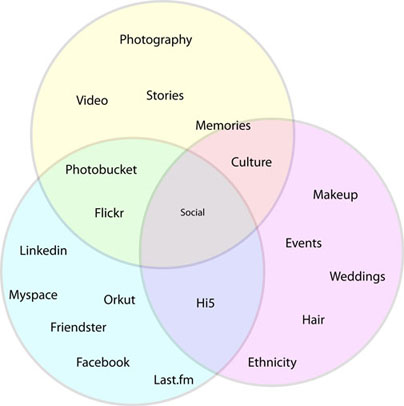


























Recent Comments